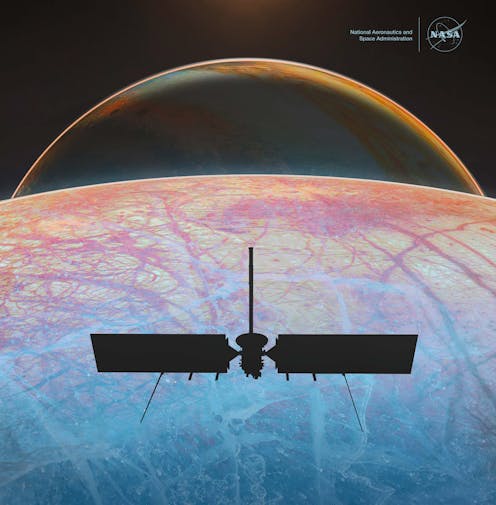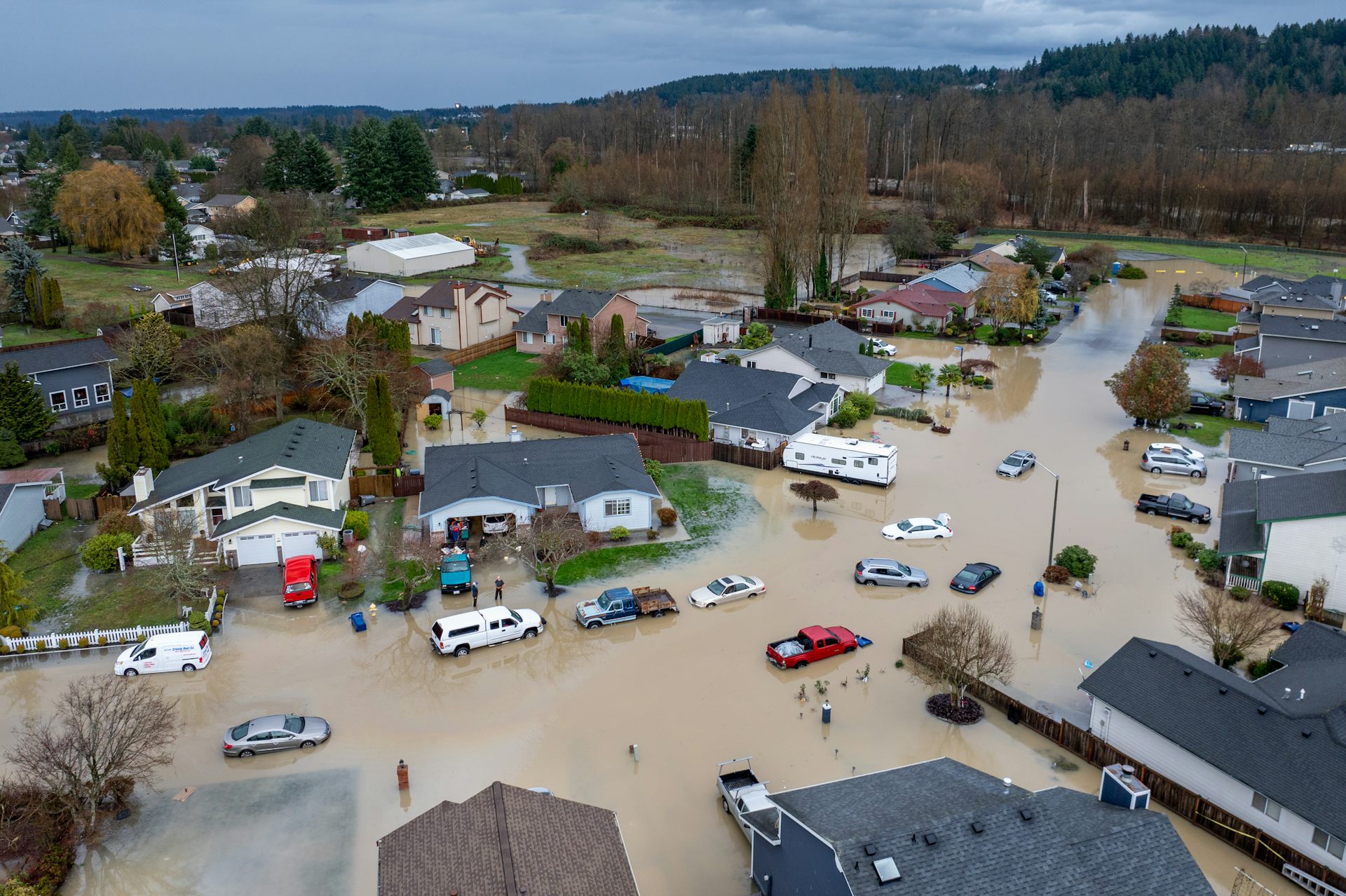NASA’s mission to an ice-covered moon will contain a message between water worlds
Europa Clipper will contain a plaque that celebrates humanity’s relationship with water and a decades-old tradition of searching for life outside Earth.

NASA’s Europa Clipper spacecraft, headed to Jupiter’s ice-covered moon Europa in October 2024, will carry a laser-etched message that celebrates humanity’s connection to water. The message pays homage to past NASA missions that carried similar messages.
As the president of Messaging Extraterrestrial Intelligence, or METI, International, I helped design the message on Clipper with two fellow members of our board of directors: linguists Sheri Wells-Jensen and Laura Buszard-Welcher. METI International is a scientific organization dedicated to transmitting powerful radio messages to extraterrestrial life.
We collected audio recordings in 103 languages, and we decided how to convert these into waveforms that show these sounds visually. Colleagues from NASA etched these waveforms into the metal plate that shields the spacecraft’s sensitive electronics from Jupiter’s harsh radiation.
I also designed another part of the message that visually depicts the wavelengths of water’s constituents, because water is so important to the search for intelligent life in the universe.
Etching messages into spacecraft isn’t a new practice, and Clipper’s message fits into a decades-old tradition started by astronomer Carl Sagan.
In 1972 and 1973, two Pioneer spacecraft headed to Jupiter and Saturn carrying metal plaques engraved with scientific and pictorial messages. In 1977, two Voyager spacecraft headed to Jupiter, Saturn, Uranus and Nepture bearing gold-plated copper phonograph records. These records contained tutorials in mathematics and chemistry, as well as music, photos and sounds of Earth and greetings in 55 languages.
Water words
As water is essential for life on Earth, searching for its presence elsewhere has been key to many NASA missions. Astronomers suspect that Europa, where Clipper is headed, has an ocean underneath its icy surface, making it a prime candidate for the search for life in the outer solar system.
Part of the Clipper message features the word for water in 103 languages. We started with audio files collected online, but we then needed to analyze those and find an output that could be engraved on a metal plate. I ended up going back to some of the techniques I used in some of my early psycholinguistic research, where I explored how emotions are encoded in speech.
The 103 spoken words we recorded represent a global snapshot of the diversity of Earth’s languages. The outward-facing side of the Clipper plate shows the words as waveforms that track the varying intensity of sound as each word is spoken.
Each person whom we recorded saying the word “water” for the waveform had a connection to water. For example, the lawyer who contributed the word for water in Uzbek – “suv” – organizes an annual music festival in Uzbekistan to raise awareness of the desertification of the Aral Sea.
The native speaker of the Catalan water word – “aigua” – hunts for exoplanets, discovering potentially habitable planets that orbit other stars.
The Drake Equation
Clipper’s message also pays homage to astronomer Frank Drake, the father of SETI – the Search for Extraterrestrial Intelligence – by bearing the Drake Equation, his namesake formula. By drawing on scientific data, as well as some best guess hunches, the Drake Equation estimates the number of extraterrestrial civilizations in the galaxy currently sending messages into the cosmos.
By one widely quoted estimate, there are a tenth as many of these extraterrestrial civilizations as one’s average lifetime in years. If civilizations survive for a million years, for example, there should be about 100,000 in the galaxy. If they last only a century on average, scientists would estimate that about 10 exist.
Radio astronomers study the universe by examining the radiation that chemical elements in space give off. They spend much of their time mapping the distribution of the most abundant chemical in the universe – hydrogen.
Hydrogen emits radiation at a certain frequency called the hydrogen line, which radio telescopes can detect. During Project Ozma, the first modern-day SETI experiment, Drake looked for artificial signals at the same frequency, because he figured scientists on other worlds might recognize hydrogen as universally significant and broadcast signals at that frequency.
The water hole
As our team developed our water words message, I realized that the message would only make sense if it were discovered by someone already familiar with the contents inscribed on the plate. The Drake Equation would only make sense if someone already knew what each of the terms in the equation stood for.
The Europa Clipper will crash into Jupiter or one of its other moons, with Ganymede or Callisto the leading candidates. But if for some reason the mission changes and it survives that fate, then humans far in the future with a radically different cultural background and different language conventions may retrieve it millennia from now as an ancient artifact.
To ensure we had at least one part of the message that a distant future scientist might be able to understand, I also designed a pictorial representation of the same frequency that Drake used for Project Ozma: the hydrogen line. We engraved this on the Clipper plate, along with a frequency called the hydroxyl line.
When hydrogen (H+) and hydroxyl (OH-) combine, they form water. Scientists call the range of frequencies between these lines the “water hole.” The water hole represents the part of the radio spectrum where astronomers conducted the first SETI experiments.
We displayed the hydrogen and hydroxyl lines using their wavelengths in the Clipper message. The metal plate also has diagrams showing what hydrogen and hydroxyl look like at the atomic level.
We’re hoping that future chemists would recognize these chemical components as the ingredients of water. If they do, we will have succeeded in communicating at least a few core scientific concepts across time, space and language.
Waveforms let our team tie the messages on the two sides of the Clipper plate together. On the water words side, over a hundred words are depicted by their waveforms. On the other side, the wavelengths of hydrogen and hydroxyl – the constituents of water – are etched into the plate.
METI International funded the collection and curation of the water words, as well as my design of the hydrogen and hydroxyl lines, providing these to NASA at no cost.
While designing the message for the Europa Clipper, we got to reflect on the importance of water on Earth, and think about why astronomers feel so compelled to search for it beneath the icy crust of Jupiter’s moon Europa. The spacecraft is scheduled to enter Jupiter’s orbit in April 2030.
Douglas Vakoch does not work for, consult, own shares in or receive funding from any company or organization that would benefit from this article, and has disclosed no relevant affiliations beyond their academic appointment.
Read These Next
West Coast levee failures show growing risks from America’s aging flood defenses
Levees protect more than 7 million buildings in the US today, yet they got a D-plus grade in 2025. A…
LA fires showed how much neighborliness matters for wildfire safety – schools can do much more to te
Managing fire risk is about more than regulations and rules. It’s also about caring for neighbors…
New materials, old physics – the science behind how your winter jacket keeps you warm
Winter jackets may seem simple, but sophisticated engineering allows them to keep body heat locked in,…






